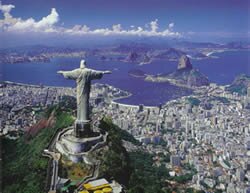Brazil Culture
 Brazilian culture has a very varied nature. An ethnic and cultural combination happened in the colonial period between three races Native Americans, Portuguese and Africans and produced the bulk of Brazilian culture. In the late 19th and early 20th centuries Italian, German, Portuguese, Arab and Japanese immigrants established Brazil and played a significant role in its culture, generating a multicultural and multiethnic society.
Brazilian culture has a very varied nature. An ethnic and cultural combination happened in the colonial period between three races Native Americans, Portuguese and Africans and produced the bulk of Brazilian culture. In the late 19th and early 20th centuries Italian, German, Portuguese, Arab and Japanese immigrants established Brazil and played a significant role in its culture, generating a multicultural and multiethnic society.Brazil is a vast and attractive country, the largest in South America, with many attractive alternatives, such as: modern cities, sunny beaches, cruises along the Amazon River, colonial towns, and spectacular waterfalls are among the many Brazil’s attractions.
Brazilian Religion
The religion of most people in Brazil is Catholicism, but many other religions over the time have been included into the Brazilian population as well as religious syncretisms, that combine Catholicism with African tribal religions. Certain denominations of Christianity have also increased a large following.Brazilian Carnival
 Carnival in Rio de Janeiro (Carnaval as is known in Brazil), is an annual celebration held forty days before Easter and marking the initiate of Lent, this is very popular in the world for the sophisticated parades staged by the city’s main samba schools in the Sambadrome.
Carnival in Rio de Janeiro (Carnaval as is known in Brazil), is an annual celebration held forty days before Easter and marking the initiate of Lent, this is very popular in the world for the sophisticated parades staged by the city’s main samba schools in the Sambadrome.Brazilian Music
Music has always been a part of every Brazilian's life and it is definitely the most highly developed art form here. Brazil's cultural tradition expands to its music styles which include samba, bossa nova, forró, frevo, pagoda, lambada, Brazilian popular music and many others.Brazil has also contributed to the genres of classical music, which can be seen in the works of numerous composers and classical performers.
Brazilian cinema
Brazil has a long film tradition. In the 1950s, Cinema Novo, appeared as a movement related with showing realism in film. In recent years, Brazilian cinema gained a new level of the international acclaim, with some films like Cidade de Deus and Carandiru. Nowadays, Brazil has a higher capacity in terms of production studios, site locations and laboratories, along with a highly qualified staff.Brazil Sports
Brazil Sports have a very strong inheritance in the country and most of the Brazilians habitually follow and participate in different sports such as: Foot volley, tennis, basketball, auto racing, volleyball, and among others. The most popular sport in Brazil is Football that is in the blood of the people of Brazil. The Brazilian national team has been champion in the FIFA World Cup competition a record five times. The second most popular sport is the volleyball. The Brazilian national team has been champion in the Olympics competition two times. Brazil is also home to numerous sports such as capoeira and Brazilian Jiu-Jitsu.Brazilian Attractive
Brazil has a diversity of attractions to the long of its territory; this is evident in the contrast of the Amazon rainforest to the mountain towns of Minas Gerais, the Sao Paulo metropolitan and the immense central plateau around Brasilia and the famous beaches of Copacabana and the legendary Ipanema. Among these beautiful places Brazil offers you the Amazonia National Park that covers almost 40 per cent of Brazil’s total landmass; Iguassu Falls, sometimes called as one of the 7 natural Wonders of the World; the statue of Christ the Redeemer is the symbol of Rio de Janeiro and one of the seven New Wonders of the Modern World.Brazilian Architecture
Brazil’s architecture is definitively diverse. Brazilian colonial architecture was derived from Portugal; with adjustments required by the tropical climate. The most typical examples of this very beautiful architecture are to be found in the churches and monasteries of the older cities, one of then, the most marvelous is Ouro Preto in Minas Gerais. This city has been carefully restored and protected as part of Brazil’s inheritance.The modern Brazilian architecture is more abundant, and the architecture of twentieth century is attributed to the work of Oscar Niemeyer, who is considered one of the most important international architects.
Some of the most striking designs are: Reidy's Museum of Modern Art in Rio de Janeiro, the Novo Museu, in Curitiba, other example is the Brazil’s National Museum in Brasilia.
Brazilian Education
Education in Brazil is separated into three levels with various grades in each level. The first education level is called the Fundamental education; it is obligatory for children between the ages of six and fourteen. The secondary education is not obligatory, and the Higher education, it is divided into both undergraduate and graduate work and is free at public universities.
Brazilian literature
Brazilianís literature refers to literature written in the Portuguese language by Brazilians or in Brazil, even if previous to Brazil's independence from Portugal.
Brazilian Recipes
This section will provide you a complete reference about Brazilian recipes. This reference includes important recipes and information about each Brazilian recipe.
© 2007-2022 All rights reserved
